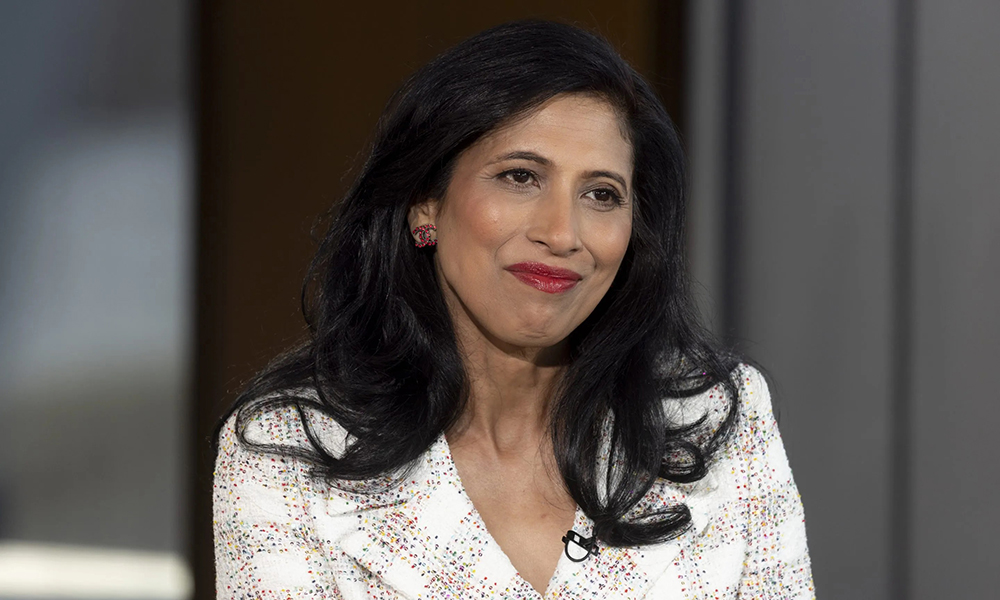
香奈兒(Chanel)史上第二位女性全球CEO莉娜·奈爾,一直在努力提高職場的性別多元化,但最近她了解到,OpenAI的ChatGPT對于這家歷史悠久的奢侈品品牌的員工結(jié)構(gòu),有著截然不同的看法。
奈爾最近在參加斯坦福商學(xué)院(Stanford Graduate School of Business)“巔峰視角”訪談活動時表示,她和她的團(tuán)隊訪問了微軟(Microsoft)的西雅圖總部,并花時間體驗了ChatGPT。
她表示:“我們說,‘給我們生成一張香奈兒高層領(lǐng)導(dǎo)團(tuán)隊訪問微軟的照片’——結(jié)果生成的圖片全是西裝革履的男士。”
奈爾在硅谷的行程還包括訪問谷歌(Google)和其他科技公司,這是香奈兒人工智能投資計劃的一部分,該計劃包括在2021年推出的Lipscanner,這是一款允許用戶虛擬試用口紅的AI應(yīng)用程序。但奈爾表示,ChatGPT生成的圖片未能反映香奈兒76%的員工(包括公司的首席執(zhí)行官)是女性這個事實。她補(bǔ)充道,該品牌96%的客戶也是女性。
她說道:“圖片中的團(tuán)隊成員100%是男性,他們甚至穿得并不時尚。拜托,它只能生成這樣的圖片嗎?”
OpenAI發(fā)言人對《財富》雜志表示,偏見依舊是人工智能行業(yè)亟待解決的一個重要問題。這位發(fā)言人在聲明中表示:“我們將繼續(xù)更新我們的模型,以減少偏見和有害的輸出內(nèi)容。”
《財富》雜志用奈爾的提示,要求ChatGPT生成一張圖片,圖片中既有男性,也有女性。香奈兒并未立即回復(fù)《財富》雜志的置評請求。微軟拒絕置評。
人工智能和奢侈品領(lǐng)域的性別偏見
ChatGPT一直有忽視領(lǐng)導(dǎo)崗位的女性運動這樣的歷史。加州大學(xué)洛杉磯分校(UCLA)2023年的一項研究現(xiàn)實,當(dāng)ChatGPT和斯坦福大學(xué)開發(fā)的大語言模型(LLM)Alpaca被要求為男性和女性求職者寫推薦信時,它們使用了“專業(yè)”和“公正”等詞匯描述男性,卻用“美麗”和“開朗”形容女性。以前,大語言模型還更有可能假定醫(yī)生等歷史上由男性主導(dǎo)的職業(yè)適合男性,并自動用代詞“他”來指代這些職業(yè)。
奈爾認(rèn)為,在公司整合AI是不可動搖的策略,但公司計劃采取措施以解決持續(xù)困擾這項技術(shù)的偏見和幻覺問題。
奈爾說道:“是的,AI無處不在,它將在我們的世界中帶來變革,因此奢侈品行業(yè)必須擁抱這項技術(shù)。香奈兒必須采用該技術(shù)。”
她補(bǔ)充說:“我們所做的事情保持倫理和誠信非常重要。我經(jīng)常和科技界的朋友們和所有的CEO們說,‘拜托,伙計們,你們必須確保在AI中整合人文思維方式’。”
嚴(yán)格的AI審查過程與奈爾之前在自己的工作場所解決性別差異的工作一致。奈爾在聯(lián)合利華(Unilever)工作了30年,并晉升為該公司的首席人力資源官。自2021年加入香奈兒以來,奈爾將公司的女性管理者比例從38%提高到約60%。
奈爾擔(dān)任全球CEO,打破了公司長期由男性高管掌舵的局面。莫琳·希凱在2007年至2016年期間是香奈兒的第一位女性全球CEO。除了她和奈爾以外,該品牌114年歷史上從未出現(xiàn)過其他女性CEO。奈爾還是公司首位印度裔CEO。香奈兒經(jīng)常會引用其女性創(chuàng)始人兼設(shè)計師嘉柏麗爾·香奈兒激進(jìn)的時尚理念。作為這家公司的負(fù)責(zé)人,奈爾毫不掩飾她想繼續(xù)改變公司長期由男性高管主導(dǎo)的現(xiàn)狀。
她曾在2023年對《華爾街日報》表示:“我做過的每一份工作都開創(chuàng)了先河。第一位女性,第一位棕色人種,第一位亞裔,第一位印度裔,但我不想成為最后一個。”(財富中文網(wǎng))
譯者:劉進(jìn)龍
審校:汪皓
香奈兒(Chanel)史上第二位女性全球CEO莉娜·奈爾,一直在努力提高職場的性別多元化,但最近她了解到,OpenAI的ChatGPT對于這家歷史悠久的奢侈品品牌的員工結(jié)構(gòu),有著截然不同的看法。
奈爾最近在參加斯坦福商學(xué)院(Stanford Graduate School of Business)“巔峰視角”訪談活動時表示,她和她的團(tuán)隊訪問了微軟(Microsoft)的西雅圖總部,并花時間體驗了ChatGPT。
她表示:“我們說,‘給我們生成一張香奈兒高層領(lǐng)導(dǎo)團(tuán)隊訪問微軟的照片’——結(jié)果生成的圖片全是西裝革履的男士。”
奈爾在硅谷的行程還包括訪問谷歌(Google)和其他科技公司,這是香奈兒人工智能投資計劃的一部分,該計劃包括在2021年推出的Lipscanner,這是一款允許用戶虛擬試用口紅的AI應(yīng)用程序。但奈爾表示,ChatGPT生成的圖片未能反映香奈兒76%的員工(包括公司的首席執(zhí)行官)是女性這個事實。她補(bǔ)充道,該品牌96%的客戶也是女性。
她說道:“圖片中的團(tuán)隊成員100%是男性,他們甚至穿得并不時尚。拜托,它只能生成這樣的圖片嗎?”
OpenAI發(fā)言人對《財富》雜志表示,偏見依舊是人工智能行業(yè)亟待解決的一個重要問題。這位發(fā)言人在聲明中表示:“我們將繼續(xù)更新我們的模型,以減少偏見和有害的輸出內(nèi)容。”
《財富》雜志用奈爾的提示,要求ChatGPT生成一張圖片,圖片中既有男性,也有女性。香奈兒并未立即回復(fù)《財富》雜志的置評請求。微軟拒絕置評。
人工智能和奢侈品領(lǐng)域的性別偏見
ChatGPT一直有忽視領(lǐng)導(dǎo)崗位的女性運動這樣的歷史。加州大學(xué)洛杉磯分校(UCLA)2023年的一項研究現(xiàn)實,當(dāng)ChatGPT和斯坦福大學(xué)開發(fā)的大語言模型(LLM)Alpaca被要求為男性和女性求職者寫推薦信時,它們使用了“專業(yè)”和“公正”等詞匯描述男性,卻用“美麗”和“開朗”形容女性。以前,大語言模型還更有可能假定醫(yī)生等歷史上由男性主導(dǎo)的職業(yè)適合男性,并自動用代詞“他”來指代這些職業(yè)。
奈爾認(rèn)為,在公司整合AI是不可動搖的策略,但公司計劃采取措施以解決持續(xù)困擾這項技術(shù)的偏見和幻覺問題。
奈爾說道:“是的,AI無處不在,它將在我們的世界中帶來變革,因此奢侈品行業(yè)必須擁抱這項技術(shù)。香奈兒必須采用該技術(shù)。”
她補(bǔ)充說:“我們所做的事情保持倫理和誠信非常重要。我經(jīng)常和科技界的朋友們和所有的CEO們說,‘拜托,伙計們,你們必須確保在AI中整合人文思維方式’。”
嚴(yán)格的AI審查過程與奈爾之前在自己的工作場所解決性別差異的工作一致。奈爾在聯(lián)合利華(Unilever)工作了30年,并晉升為該公司的首席人力資源官。自2021年加入香奈兒以來,奈爾將公司的女性管理者比例從38%提高到約60%。
奈爾擔(dān)任全球CEO,打破了公司長期由男性高管掌舵的局面。莫琳·希凱在2007年至2016年期間是香奈兒的第一位女性全球CEO。除了她和奈爾以外,該品牌114年歷史上從未出現(xiàn)過其他女性CEO。奈爾還是公司首位印度裔CEO。香奈兒經(jīng)常會引用其女性創(chuàng)始人兼設(shè)計師嘉柏麗爾·香奈兒激進(jìn)的時尚理念。作為這家公司的負(fù)責(zé)人,奈爾毫不掩飾她想繼續(xù)改變公司長期由男性高管主導(dǎo)的現(xiàn)狀。
她曾在2023年對《華爾街日報》表示:“我做過的每一份工作都開創(chuàng)了先河。第一位女性,第一位棕色人種,第一位亞裔,第一位印度裔,但我不想成為最后一個。”(財富中文網(wǎng))
譯者:劉進(jìn)龍
審校:汪皓
Chanel’s second female global CEO Leena Nair, who has worked to increase gender diversity in the workplace, recently learned that OpenAI’s ChatGPT had a much different idea about the demographic makeup of the legacy luxury brand.
Nair and her team visited Microsoft’s Seattle headquarters and spent time experimenting with ChatGPT, Nair said in a recent Stanford Graduate School of Business “View from the Top” interview.
“We’re like, ‘Show us a picture of a senior leadership team from Chanel visiting Microsoft’—it is all men in suits,” she said.
Nair’s Silicon Valley trip also included a visit to Google and other tech firms—part of Chanel’s push into AI investment, including Lipscanner, an AI-powered app allowing users to virtually try on lipstick, which it introduced in 2021. But she said the image ChatGPT created to depict her team failed to account for Chanel’s employee makeup of 76% women—including the company’s own chief executive. She added that 96% of the brand’s clientele is also women.
“It was a 100% male team, not even in fashionable clothes,” she said. “Like, come on. This is what you’ve got to offer?”
An OpenAI spokesperson told Fortune that bias continues to be a significant issue in artificial intelligence the industry is addressing. “We are continuously iterating on our models to reduce bias and mitigate harmful outputs,” the spokesperson said in a statement.
Fortune asked ChatGPT to generate an image with Nair’s same prompt, and it created an image of both men and women. Chanel did not immediately respond to Fortune’s request for comment. Microsoft declined comment.
Gender biases in AI—and luxury
ChaptGPT has a history of slighting the movement of women in leadership roles. A 2023 study from UCLA showed that when ChatGPT and Alpaca, a large-language model (LLM) built by Stanford University, were both asked to write recommendation letters for male and female candidates, they used words like “expert” and “integrity” to describe men, and “beauty” and “delight” to describe the women. LLMs have also previously been more likely to assume historically male-dominated occupations like doctors are for men, and will automatically latch “he” and “him” pronouns to those occupations.
Nair believes that integrating AI into her company is nonnegotiable, but plans to introduce measures to address biases and hallucinations that continue to plague the technology.
“AI is everywhere, yes, and it’s going to be transformative in our world, so luxury has to engage with it. Chanel has to engage with it,” Nair said.
“It’s so important that we keep the ethics and integrity of what we’re doing,” she added. “I constantly talk to my friends in tech, all the CEOs, saying, ‘Come on, guys, you gotta make sure that you’re integrating a humanistic way of thinking in AI.’”
The careful AI-vetting process aligns with Nair’s previous work to address gender disparities in her own workplace. Since her tenure at Chanel began in 2021—after working 30 years at Unilever, where she rose to the rank of chief human resources officer—Nair has increased the company’s percentage of female managers from 38% to about 60%.
Nair’s role as global CEO disrupts a long line of male executives that have helmed the company. Beyond Maureen Chiquet, who served as Chanel’s first female global CEO from 2007 to 2016, no other woman besides Nair has had the title of chief executive in the brand’s 114-year history. Nair is also the company’s first Indian CEO. As the head of a company that frequently invokes the radical fashion ideology of its female founder and designer, Gabrielle Chanel, Nair isn’t shy in her desire to continue to deviate from Chanel’s long line of male executives.
“I’ve been the first at every job I’ve done,” she told the Wall Street Journal in 2023. “The first woman, the first brown person, the first Asian, the first Indian—but I don’t want to be the last.”






